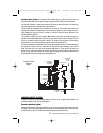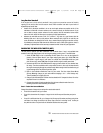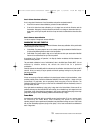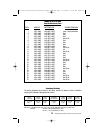
12
Edelbrock Performer Series Carburetor Owner’s Manual 8/94
Long Duration Camshaft
If the engine has a fairly radical camshaft it may require an excessive amount of throttle
opening for idle and/or have low idle vacuum levels. Either condition can lead to poor levels of
adjustability and erratic idles.
• Another fix for the above condition is to run as much spark advance as possible at idle. If the
distributor is fitted with a vacuum advance unit, connect it directly to manifold vacuum. If you
are not able to employ vacuum advance for some reason, then the mechanical curve should
have a low limit, which will allow you to use plenty of initial spark advance.
• Measure the manifold vacuum at idle. If it is below 7” Hg, there is a good chance that the
Metering Rods are in the up (rich) position. When combined with a high idle air rate this can
cause the Nozzles to discharge fuel at idle. Use a weaker Step-Up Spring (see section on Step-
Up calibration) to keep the Rods down at idle. With some cams, a stiffer spring (pink or silver) is
necessary. Experimentation is the best way to determine which is best for your application.
CALIBRATING THE WIDE-OPEN-THROTTLE (WOT)
The best place to perform your WOT calibration is on a chassis dyno. If one is not available then
consider a safe, legal driving space, such as a drag strip where you are given E.T. and MPH data.
1. Select an RPM Range to use in evaluating the WOT power. As a rule, use the highest 50
percent of the real power band. If your engine makes good power up to 5000 RPM, then
2500-5000 is a good range. If peak power is at 6500, then 3500-6500 would be a good
pick. Be sure not to select RPMs that are higher than the engine’s useful power band.
2. Accelerate at WOT from 1000 RPM below the range you have elected to a few hundred over
the range. Time the acceleration with a stop-watch. Be sure to time only the interval while
the engine is sweeping through the selected range. Make enough timed accelerations to get
a good average that is not affected by wind or grade.
3. Refer to the Calibration Reference Chart for your model. Find the richest Power Mode
(Primary Metering) change you can make without changing a Jet — a Rod change only.
This will probably be 2 stages (8%) rich.
4. Change to the indicated Rods. Perform timed acceleration #2. Compare the times. Do not be
surprised if there is no difference.
5. Compare the results of timed acceleration #2 to the base calibration and refer to the
following section that best describes your situation:
Case 1: Faster than base calibration
Change Secondaries 2 stages richer and perform acceleration test #3.
• If test #3 is the same as #2, you’re done.
• If test #3 is slower than #2, change to 1 stage rich for the Primary and Secondary and you’re
done.
• If test #3 is still faster than #2, go to 3 stages rich Primary and Secondary and keep going richer
until there is no change (or slower) in the times. Stay at the first “no change” level, so that you
stay with the richer of any two levels of calibration that have the same power.
1403-1413 Perf Series Carburetor Owner's Manual.qxd 3/31/2006 12:04 PM Page 12


















